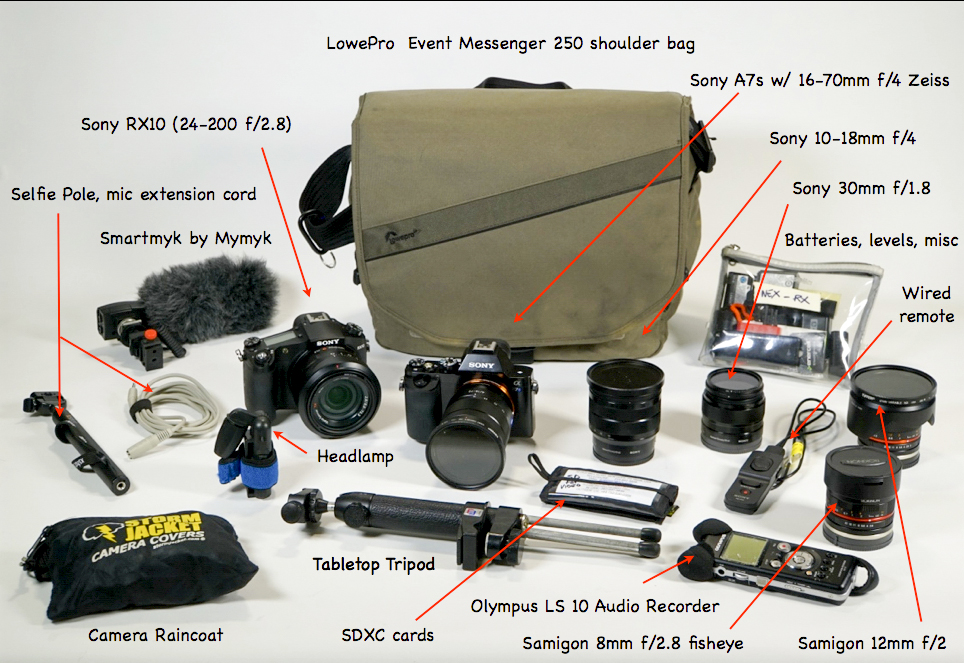For me, a camera bag is a constantly evolving beast, especially these days as I complete my transition to mirrorless video maven. I’m teaching a couple of seminars on travel photography for National Geographic Traveler in the next couple of months, and so it was time to update the pictures of my latest gear configuration for travel. Here’s a breakdown of what I take on travel gigs these days…

This is the beast fully loaded, and even at that, it’s about half the weight of my old DSLR setup. I will often leave the fisheye Rokinon behind. But it’s nice having relatively fast lenses like the Rokinon 12mm f/2 (18mm equivalent) and the 35mm f/1.8 (50mm equivalent) ready to grab.
Let’s go over the thinking behind this bag. For the first time I can remember, my outfit does not include two matching bodies…I never went out without a matching pair of compact Nikon DSLRs..but that was before the advent of mirrorless cameras of theRX10‘s quality with a built-in Zeiss lens that is the 35mm equivalent of a 24-200mm f2.8 on the camera’s one inch chip.
Think of that; a super sharp, reasonably fast 24-200mm with a constant f/2.8 lens. Oh yeah, the full frame pixel peepers are going to go on about the chip size but for both still and especially video purposes, in my opinion, this is the best shot-grabbing, all-in-one travel camera ever made (there, I said it). With the latest firmware upgrade that got us out of the awful compressed AVCHD codec and into a broadcast quality, 50mbps X AVCS codec, Sony has just knocked this out of the park.
But one camera can’t do everything and one thing that the RX10 doesn’t do too well is that soft-background creamy bokeh full frame look (it’s a matter of sensor size, not a design failure). And the images can get noisy above ISO 1600 (which is still an excellent high ISO threshold for a smaller chip camera). And while 24mm is wide enough for most things, I love an ultrawide look too.
And that’s where the A7s comes in. It’s a lowlight monster, and is usable in two modes—full frame, and APS-C mode. I use it primarily in the latter mode for two reasons. First, most of my Sony lenses are for the NEX series which were all APS-C sized chips. And secondly, because in video mode, the APS-C mode is less prone to rolling shutter, that phenomenon that can create a wavy video image if you’re moving the camera around too fast (which you shouldn’t be if you’re shooting video, but hey, sometimes you’re not as stable as you want to be).
Recently, in Iceland, I shot video with the A7s at ISO 25,400 (or something like that) in a shepherd’s hut lit with a couple of little candles and it looked fabulous. I don’t know how they did it, but this camera shines at ISO’s so high that you really need night vision goggles to see what the camera can see.
So on this camera, I have my 10-18mm (which in APS-C mode is equivalent to a 15-28mm approximately). I also carry the sharp Zeiss 16-70mm f/4…what a nice lens; Optical Image Stabilization, and a range (35mm equivalent would be a 24-105mm) that will cover almost everything I usually need in any given situation.
For low light and nice bokeh, I’ve got the tiny, sharp, optically stabilized (way to go Sony, offering stabilization in fast primes!) 35mm f/1.8. It’s great for those face closeups with good bokeh, like this one:

The rest of the gear is pretty self-explanatory. The table top tripod doubles as a kind of chest or belly brace for handheld shooting. I come from the “time before selfies,” so I don’t really shoot them, but the selfie pole and the mic extension cord allow me to mount the ultra light Smartmyk mini shotgun on it and do a one-handed boom mic arrangement for impromptu interviews. The Olympus audio recorder is for capturing ambient sound.
The camera raincoat, the bag o’ batteries, the cable release are standard issue items. But the result is a bag I sling over my shoulder (bandolero-style so the bag rides in the small of my back until I need to get something out of it), that I can carry all day, every day, and be ready for just about anything!